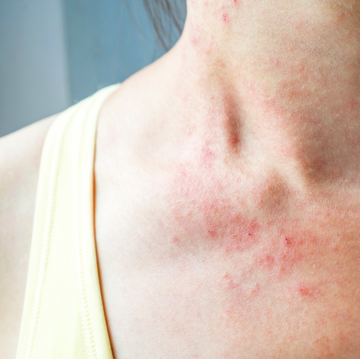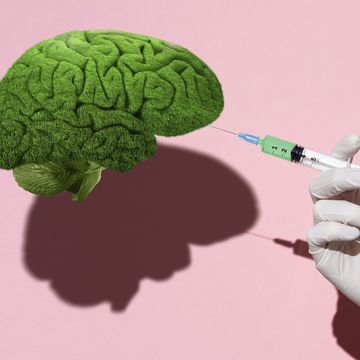While many food reactions occur in children, adults are not immune to receiving a food allergy diagnosis.
For Grace Guthrie, it had been a stressful season so she was psyched for the long weekend she and her boyfriend, Duncan, had planned in Arkansas’s Ozark Mountains in January 2020. The area had great museums and mountain views, and her parents had given her a gift certificate for a famous restaurant.
The couple was visiting an art museum when they stopped to eat lunch at its café. Guthrie, a 29-year-old dietetic intern at the University of Kansas Medical Center, had known she was highly allergic to peanuts since she’d had a bad reaction to them as a toddler. But she was not allergic to tree nuts, so after mentioning her peanut allergy to the waiter she ordered the cashew–sweet potato soup and a grilled cheese sandwich. The meal was delicious. But 10 minutes after Guthrie had eaten her first spoonful of the soup, her mouth began to tingle and she felt a lump in the back of her throat. Guthrie had had about a dozen peanut-allergy attacks, and mouth tingling was the first sign. But in the past, when she’d had only a whiff (as she thought might have been the case this time, from possible cross-contamination of her soup), the reaction had been mild. “I didn’t want to overreact and scare my boyfriend, so I didn’t mention anything at that point,” she says.
As the couple resumed their stroll through the galleries, Guthrie’s nose began running and she started to sneeze. Ducking into the ladies’ room, she popped a Benadryl, hoping it would end the reaction. Minutes later, Guthrie felt her throat begin to tighten and dry up. Her breathing became slightly labored. In a hoarse, croaking voice, Guthrie told Duncan he needed to drive her to the ER immediately.
By the time they arrived minutes later, her sinus cavities had swelled so much that they pushed her itchy eyes apart like a grasshopper’s. Hives had sprung up on her chest, neck, and face. Most troubling, it became harder to breathe. Her heart was racing, no doubt because her body sensed that if she didn’t get medical treatment soon she could die. The minute she told the nurse at the ER that she was having a peanut reaction, they whisked her inside. “At that point I felt calm. I knew I was about to get the care I needed,” she recalls.
Food allergies are on the rise in adults
In recent years, the number of adults with life-threatening food allergies has increased significantly. Some are developing an allergy for the first time, most commonly to shellfish, says Ruchi Gupta, M.D., an allergy researcher and a professor of pediatrics and medicine at Northwestern University’s Feinberg School of Medicine. Others first became allergic as children. In the past few decades, rates of childhood food allergies have risen dramatically, and some sufferers carry their allergies into their grown-up years. “Some allergies are frequently outgrown, but many continue into adulthood,” Dr. Gupta says.
In 2019, Dr. Gupta and her colleagues surveyed more than 40,000 adults to try to get a sense of the scope of the problem. They were shocked to find that more than 10%—some 26 million adults—had food allergies, with about a third saying a reaction had sent them to the hospital. A whopping 48% had developed their food allergies as adults. “We did not expect such a large number. But when you talk to adult allergists, they confirm that it’s what they’re seeing,” she says. The most common culprits overall are shellfish, milk, peanuts, tree nuts such as almonds and cashews, fish, eggs, wheat, and soy, the study found.
What’s going on in the immune system
Food sensitivities, often mistaken for allergies but not as serious, arise from problems digesting certain proteins, which may lead to gas or bloating. For the issue to be a true allergy the immune system must be triggered.
All allergic reactions (whether to food or to something like a bee sting) start when the immune system mistakes proteins in a substance for something dangerous. This launches the helper T cells in the blood that are normally called up to fight infections. The activation of the T cells leads to production of the immunoglobulin E (IgE) antibodies that reside on mast cells around the body; these quickly release histamine and other chemicals to expel the proteins through means like sneezing or the dilation of blood vessels to help purge them through the skin. “These histamine reactions are likely there to protect us if we accidentally take in a toxin,” says Elise Liu, M.D., Ph.D., an allergist and immunologist at Yale Medicine. Such a swift, extreme, full-body response would make perfect sense if you’d swallowed a poison instead of a peanut. “It’s a good reaction that’s been co-opted by an inappropriate response to a food,” Dr. Liu says.
Food allergy symptoms
Many reactions begin like Guthrie’s, with a sensation in the mouth and throat, where the food enters the body, Dr. Liu says. The histamine released in Guthrie’s upper respiratory tract soon caused sneezes and a runny nose. Histamine makes blood vessels dilate, which was the reason her sinus cavities swelled, and it also affects the skin, hence her hives. Some allergic reactions can also involve the GI tract and the nervous system—with accompanying abdominal pain, nausea, vomiting, diarrhea, mood changes, or confusion.
Most dangerously, the swelling triggered by an allergic reaction can narrow airways, affecting breathing. Equally serious is when dilated blood vessels cause blood pressure to plummet, preventing the heart and other crucial organs from getting a sufficient blood supply. These extreme symptoms, known as anaphylaxis, don’t occur with every allergic reaction, but when they do they can be lethal. In fact, food allergies are responsible for about 150 deaths in the U.S. each year.
Testing for a food allergy
Anyone who thinks they have a food allergy should be tested by an allergist, who will ask about prior reactions, Dr. Gupta says, so it helps to start a food and symptom log before your appointment. You will likely be asked to take one of two tests: a blood test, done by a lab, or a skin test (also called a percutaneous test), in which potentially problematic substances are pricked or scratched into the skin. Doctors should test only foods you have a history of reacting to, Dr. Gupta says, because of the high rate of false positives.
If the test doesn’t yield a definitive answer, you might be asked to take an oral food challenge in which you’re given a minute amount of a food and watched for a reaction—a risky proposition if you are in fact allergic to it, which is why you should do this only under medical supervision. Still, many discover that they have an intolerance of a particular food, not an allergy to it, and they may be able to enjoy that food by taking certain precautions, such as putting lactase drops into milk or other dairy products to help break down troublesome sugars. If you are found to be allergic like Guthrie, strictly avoiding the problem food is a must, and severe allergic reactions require treatment with an epinephrine auto-injector, often followed by emergency room monitoring. Less severe allergic reactions (those in which the reaction is limited to one body part, such as the skin, and does not affect breathing or the heart) may be effectively treated with an antihistamine such as Benadryl.
Still, having had a mild reaction in the past doesn’t guarantee that future reactions will be similarly mild, as numerous factors—including how much of the food you ate, whether you recently had an illness or exercised, and where you are in your menstrual cycle—can affect your reaction. The menstrual cycle link points to the potential role of hormones, especially since boys are more likely to have food allergies as kids but by adulthood more women do.
Food allergy treatments
There is a relatively new FDA- approved treatment for peanut allergies, Palforzia, that might have made a difference for Guthrie had it been around when she was a child. This oral immune therapy involves giving minute amounts of peanut protein powder in increasing doses over time to teach a child’s immune system to tolerate it. Many doctors use the treatment for adults, but the earlier it is started, the better the outcome, Dr. Gupta says. Other intriguing methods to prevent severe reactions or possibly reverse allergies are also being researched:
Immunotherapy: A patch that goes on the skin, sublingual (under-the-tongue), and oral formulas are being tested, Dr. Gupta says.
Microbiome: The critters in our guts are increasingly thought to play a role in food allergies. Altering them with prebiotics, probiotics, or even fecal transplants may make a difference.
Biological drugs: Medicines for eczema and asthma, including Xolair (omalizumab) and Dupixent (dupilumab), are being studied for food allergies too.
The lack of great options is the reason allergy doctors say anyone with a food allergy must always carry an epinephrine auto-injector, such as EpiPen or Auvi-Q, which, when pressed against the outer thigh to inject the substance, can help relieve symptoms. “It is safe and works really fast,” Dr. Gupta says. Even after giving yourself such an injection, though, you should seek medical care so you can be assessed and monitored.
As for Guthrie, after she ate the soup, she didn’t use her auto-injector as she normally would have in a similar situation, because she knew she was close to the hospital and she was dressed in layers of winter wear and couldn’t easily access her thigh. At the hospital ER, she received an IV of epinephrine and a steroid. Her symptoms began resolving immediately, and she was discharged within a few hours. (Note that delaying epinephrine like this is not recommended, as symptoms can escalate quickly, Dr. Gupta says.)
Dealing with her peanut allergy was what prompted Guthrie to return to school part-time to become a dietitian. She also started a blog called Foods With Grace for people with allergies. But she is determined not to let allergies limit her life.
Once Guthrie left the hospital and took a nap at her Airbnb, the couple went to the restaurant for which she had the gift certificate. “I’d really been looking forward to it, and I wanted to do something fun after spending hours in the hospital,” she says. She enjoyed her dinner—but after all that drama, she decided to skip dessert, knowing that baked goods are common places where peanuts can hide.
How to eat with confidence
Strictly avoiding certain foods is not easy, says Elizabeth Pecoraro, R.D.N., an allergy-focused nutritionist in Katonah, NY, and the author of The Allergy-Friendly Cookbook. Here’s how you (or your child) can cope better.
Read obsessively
Scan ingredient labels at the store, again when you get home, and once more before using the food to be sure you haven’t missed something, Pecoraro advises. This is important even with brands you buy regularly, because formulations are constantly changing. Also read labels on non-food items like lotions, soaps, and medicines, as they may contain nuts and other problematic ingredients.
Call the manufacturer
“May contain” allergy info on labels, which generally means food is made in the same facility as products with that ingredient, is not required by law. If you don’t see it, call the company and ask what plant the food is processed in and what else is made on that production line, she advises.
Have a plan
Before eating away from home, know how you’re going to avoid your allergens. “When traveling, are you going to pack your own food, order groceries, or eat out?” Pecoraro asks her clients. Check restaurant menus online and call to ensure that they can accommodate you. (You must still clearly state your allergens to your waiter, or ideally the chef, after you arrive.) Be sure friends and family understand how allergens can be hidden: Sauces and dressings often contain egg, for instance; soy is in many prepared foods. Also, always have two sets of epinephrine self-injectors with you and know where the nearest ER is.
Don’t ignore your emotions
Food allergies can be stressful. Guthrie says she is often on high alert for weeks after a reaction. Pecoraro recommends joining a social media support group or talking to a food-allergy dietitian or a therapist if your anxiety won’t quit.













